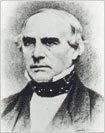In the late 1850s, John Warren Butterfield built a mass transit
system to link California to the rest of the United States.
Recently, I’ve wondered what Butterfield would think of the
proposed California
”
bullet train,
”
a futuristic mass transit system that might one day link the Bay
Area to Los Angeles.
In the late 1850s, John Warren Butterfield built a mass transit system to link California to the rest of the United States. Recently, I’ve wondered what Butterfield would think of the proposed California “bullet train,” a futuristic mass transit system that might one day link the Bay Area to Los Angeles.
Building reliable mass transit systems is vital for America’s efforts to achieve energy independence. That’s why a high-speed rail service spanning California is such an important goal. Already popular in Europe and Japan, the bullet train would be the first such system in America.
In August, the proposed route was discussed at public forums in several Silicon Valley cities, including Gilroy. The multi-billion-dollar question is: Where should the train cross the Diablo Mountains? Environmentalists advocate the East Bay’s Altamont Pass route along Interstate 580. The South Valley’s Pacheco Pass route, however, would provide significant commercial and economic benefits to the Silicon Valley region including Morgan Hill, Gilroy and Hollister.
There are pros and cons arguments to both proposed routes, but I find myself favoring Pacheco Pass. I’m keen on this route because it historically connects our 21st century world to the America’s Old West. Winding over Pacheco Pass on its way from San Francisco to L.A., passengers would closely follow the path of America’s most famous overland stagecoach.
Public stagecoaches began operating in California during the Gold Rush era. The first stage line started offering service in the autumn of 1849, taking passengers between San Francisco and San Jose along El Camino Real in an old French omnibus pulled by mules. The 9-hour ride down this dusty or muddy road (depending on the season) cost $32 in gold coins.
Quickly, as California’s population grew, other stagecoach lines created a network of mass transit services across the state. And that brings us back to Butterfield who saw the money-making business opportunities for stage service connecting California to the rest of the union.
Butterfield started his career at age 19 as a professional stage driver in New York. Over time, he became the owner and operator of a livery stable called Butterfield & Wasson Company. In 1850, at the age of 49, he convinced businessmen Henry Wells and William Fargo to consolidate their successful Wells Fargo stage company with him. Butterfield served as the director of the newly formed American Express Company, which carried mail and passengers between various East Coast cities. (The firm later evolved into the credit card provider.)
With ambitious zeal to expand his enterprise, Butterfield campaigned against nine other companies for a lucrative contract to haul mail from St. Louis to San Francisco in 25 days. Because of his past success with American Express, the U.S. government awarded him the contract worth $600,000 annually – the largest land-mail contract ever awarded at that time.
Butterfield spent more than a million dollars building a system of relay stations that could service the 250 Concord Stagecoaches traversing the arduous 2,812 mile trek.
Passengers paid $200 to cram into a coach and bounce about on rough roads virtually non-stop for three weeks. One such passenger, a New York Herald journalist named Waterman Ormsby, undertook the adventure the entire distance. He reported: “Had I not just come out over this route, I would be perfectly willing to go back, but I now know what Hell is like. I’ve just had 24 days of it.”
The L.A. to San Francisco portion of the trip covered 462 miles and lasted about 80 hours. The route stretched up the Central Valley, crossed over Pacheco Pass, and connected to the El Camino Real (now Monterey Highway) in Gilroy. Horses were changed and stagecoaches were serviced in a small relay station and blacksmith shop in the village of Madrone, now in the northern district of Morgan Hill.
The Butterfield Overland Stage lasted from 1857 to 1861. In the South Valley today, its only real vestige is Morgan Hill’s Butterfield Boulevard.
The spirit of Butterfield’s mass transit system still continues, however, with the proposed high-speed rail system that would carry passengers comfortably from San Francisco to L.A. in two hours. If Pacheco Pass is chosen as the Diablo range crossover, this train would essentially follow Butterfield’s famous stagecoach route.
The ambitious entrepreneur Butterfield would definitely nod his head in approval of the massive project estimated to cost $40 billion. And, for the sake of Old West nostalgia, I think he’d whole heartily recommend the South Valley route.













